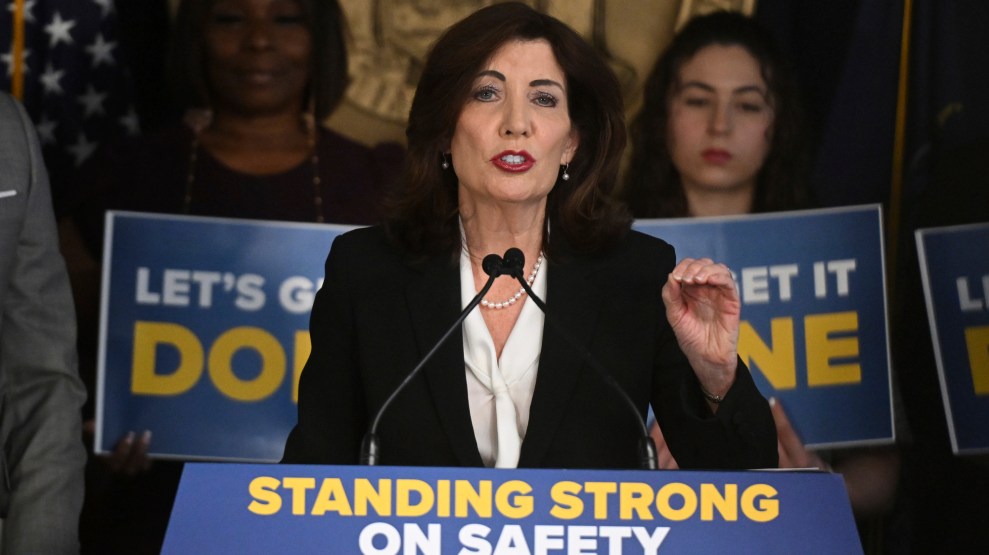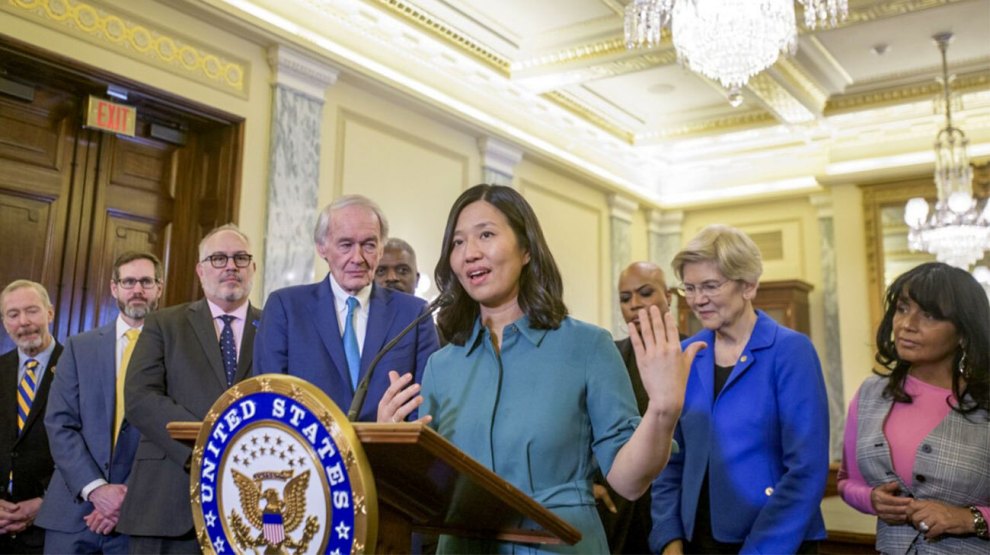Today, more than 20 years since the beginning of affirmative action programs and the social change that led to them, Jews, women, African Americans, Latinos, and Asian Americans sit on the boards of the country’s largest corporations; presidential cabinets have become increasingly diverse; and the highest ranks of the military are no longer filled solely by white men.
The rules, however, remain the same as in 1956 when C. Wright Mills’ The Power Elite described the exclusively white, male, and Christian makeup of the leading members of America’s political, military, and business institutions. The broad social movements of the 1960s and ’70s sought to diversify this elite—and, in the process, shift its values to reflect greater social equity—but failed to change the most important factors in attaining membership. Indeed, the diversity “forced” upon the power elite has given it buffers, ambassadors, and tokens through the women and minorities who share its prevailing values. Discrimination is still widespread, and the ascension of different groups, albeit uneven, depends on four factors:
CLASS: For the most part, it takes at least three generations to rise from the bottom to the top. Fully one-third of women in the elite are from the upper class. Most of the Cuban Americans and Chinese Americans come from ruling-class families displaced by political upheaval. The Jews and Japanese Americans are the products of two- and three-generational climbs up the social ladder. And the first African Americans to serve in cabinets and on the boards of large corporations tended to come from the small black middle class that predated the civil rights movement.
EDUCATION: The women and minorities who make it into the corporate elite are typically better educated than the white males who are already a part of it, but time and again they emerge from the same institutions: Harvard, Yale, Princeton, and MIT on the East Coast; the University of Chicago in the Midwest; Stanford and the University of California at Berkeley on the West Coast.
SKIN COLOR: African Americans and Latinos who do make it into the power elite are lighter-skinned than other prominent members of their racial group. As Colin Powell told Henry Louis Gates Jr. in the New Yorker, explaining his popularity among whites: “Thing is, I ain’t that black.”
“IDENTITY MANAGEMENT”: As Terie Miyamoto, an Asian American U.S. West executive, puts it, the challenge is to move into a “comfort zone” with those who decide who is and is not acceptable for inclusion. Cecily Cannan Selby, the first female board member of Avon Products, cites her first dinner with the previously all-male Avon board: The tension in the room, she says, was visibly reduced when she lit up a cigar. Hedging against traditional stereotypes, Jewish and black executives must be properly reserved, Asian American executives properly assertive, gay executives traditionally masculine, and lesbian executives traditionally feminine.
The new members of the corporate elite may differ in appearance from the old guard, but their actions are strikingly similar. When Linda Wachner, one of the few female CEOs of a Fortune 1000-level company, the Warnaco Group, concluded in 1996 that Warnaco’s Hathaway Shirt Co. was unprofitable, she decided to close down the factory. It didn’t matter to her that Hathaway had been making shirts there since 1837, that almost all of the factory’s 500 employees were women, or even that the workers had given up a pay raise to hire consultants to teach them how to work more effectively. The company was not making enough money, and she deemed the average worker’s $7.50 hourly wage too high. (In 1995, Wachner received $10 million in salary and stock.)
While the new members of the corporate elite mostly have the same background as their white counterparts, the relatively few rags-to-riches stories occur among politicians who come up through the electoral process, usually within the Democratic Party. In general, Congress is more diverse than the corporate world, and elected women and minorities are more likely to be Democrats than Republicans. Meanwhile, the new corporate elite members tend to join the GOP. Thus both Republicans and Democrats can claim they represent women and minorities.
In the 1960s, those who challenged the homogeneity of the country’s boardrooms and halls of government had hoped new perspectives would bring greater openness throughout society. But as activists, political leaders, and the courts came to focus more and more on individual rights, the emphasis on social class and “distributive justice” was lost. The age-old American commitment to individualism, reinforced at every turn by corporate leaders, won out over the commitment to a greater equality of income, once a central strand of New Deal liberalism. The power elite now simply has a kinder, gentler, more diverse face.
Richard L. Zweigenhaft is Charles A. Dana Professor of Psychology at Guilford College in Greensboro, N.C.; G. William Domhoff is Research Professor of Psychology at the University of California at Santa Cruz. Introduction and anecdotes excerpted with permission from Diversity in the Power Elite: Have Women and Minorities Reached the Top? (Yale University Press, spring 1998).
| WOMEN | Hazel R. O’Leary, 60; president of Hazel R. O’Leary Associates; B.A., Fisk University; J.D., Rutgers University. |
In 1992, the soon-to-be secretary of energy commented on the value of fitting into corporate culture: “Without losing your own personality,” said Hazel O’Leary, then an executive vice president at Northern States Power in Minnesota, “it’s important to be part of the prevailing corporate culture. At this company, it’s golf. I’ve resisted learning to play golf all my life, but I finally had to admit I was missing something that way.” Hazel O’Leary now plays golf.
As women climb the corporate ladder, they adapt their behavior to fit in. White male managers, according to a 1995 Federal Glass Ceiling Commission report, support hiring women and minorities as long as they are not too different. “What’s important,” said one manager, “is comfort, chemistry, relationships, and collaborations.”
Women directors most frequently take the business route to corporate board membership. But while men typically spend 15 years moving up the ranks, eventually joining the board, women are more likely to head small companies or work as consultants and serve as outside directors. Other common paths include academia, volunteer jobs (top positions with charitable and cultural organizations), and legal careers.
Channeled into labor relations and PR, women at the top not only present an image of diversity, but also provide a buffer between the corporation’s managers and those who provide its labor force (as well as the public). In this “velvet ghetto,” women play an important corporate role, yet few hold positions with responsibility for the bottom line.
| JEWS | Michael Eisner, 55; CEO and chairman of Walt Disney; B.A., Denison University. |
On December 14, 1973, the Wall Street Journal announced: “Boss-to-Be at DuPont Is an Immigrant’s Son Who Climbed Hard Way.” Irving Shapiro was the first Jew to achieve such a prominent position in a corporation that had not been founded or purchased by Jews.
No such headline greeted the 1984 announcement that the Walt Disney Co., founded by a man who had refused to hire Jews, picked as its CEO Michael Eisner, a Jew from a wealthy New York family. By 1995, while Jews totaled 2.5 percent of the U.S. population, they represented 7.7 percent of those on corporate boards.
Being Jewish has become a progressively less important cause for discrimination, in part due to assimilation. Second- and third- generation Jews among America’s economic elite are less involved in Jewish circles and less likely to marry Jews.
In a study of Harvard Business School graduates, Jewish and non-Jewish managers both noted that certain Jews were more likely to be successful than others. “If an individual is perceived as quite Jewish…it may have a negative impact,” said one Jewish respondent. “Those who have moved faster are the less visible Jews.”
An even more pointed comment came from a non-Jew: “I think at the top levels being Jewish will hurt a person’s chances. But it depends on how he plays his cards. This one man I know is so polished, such an upper-class person, there’s no way to know he’s Jewish. I’ll admit I’m prejudiced. There are certain aspects of Jewish people I don’t like—they’re pushy, they’re loud, especially those damn New York bastards. My friend is fine, however. He’s an upper-class-type person, the kind who could make it to the top.”
| AFRICAN AMERICANS | Vernon E. Jordan Jr., 62; senior partner at Akin, Gump, Strauss, Hauer & Feld; B.A., DePauw University; J.D., Howard University School of Law. |
At the annual General Motors stockholders’ meeting in the spring of 1970, a group calling itself Campaign GM attacked the company’s minority-hiring policies. At the time, there were no blacks on GM’s board of directors and blacks owned only 14 percent of the 13,600 GM dealerships.
Responding to the group’s questions, CEO James Roche made an embarrassing slip: “We are a public corporation owned by free, white…,” he said, finally adding, “umm…and…and…and black and yellow people all over the world.”
Several months later, Roche asked Leon Sullivan, an activist minister in Philadelphia, to join the board. Unlike other blacks on corporate boards, Sullivan came from an impoverished background and had attended a non-elite college. Even today, his appointment is more the exception than the rule.
African Americans remain underrepresented on corporate boards. Although blacks accounted for about 11 percent of the population in 1964 and about 12 percent in 1995, the percentage of seats held by blacks on Fortune-level boards during that same period rose from zero to only about 3.6 percent. Most black board members come from outside corporate ladders—law firms, universities, or black-owned businesses.
Politically, they include both conservatives and liberals—though the traditionalists far outnumber the activists. Even the few activists tend, over time, to become part of the establishment. A 1993 profile in Current Biography explains Democrat Vernon Jordan’s willingness to join corporate boards: “During his 10 years at the helm, he greatly expanded the influence of the National Urban League by enlisting the cooperation of some of the largest corporations in the United States. As part of that effort, he began serving on the boards of directors of such corporate giants as J.C. Penney, Xerox, and American Express.” Jordan was also expanding his own influence. And no doubt his close friendship with Bill Clinton, and reported role in the Monica Lewinsky affair, now qualifies him as the ultimate insider.
| ASIAN AMERICANS | Wendy Lee Gramm, 53; consultant; B.A., Wellesley College; Ph.D., Northwestern University. |
From 1992 to 1995, the number of Asian Americans on the boards of 750 publicly held companies rose from 15 to 26. Most are Chinese Americans or Japanese Americans; one is Korean American: economist Wendy Lee Gramm, who’s married to conservative GOP Sen. Phil Gramm. Born in 1945 in Hawaii (her father was a sugar company executive), she met Gramm in the 1970s, when they both taught economics at Texas A&M. George Bush appointed her to the Commodity Futures Trading Commission in 1988; she served on the board of the Chicago Mercantile Exchange in the ’90s and is now a director of Enron.
Given the relatively small number of Asian Americans in the U.S. and the stereotypes they face, Asian Americans’ record of corporate involvement is impressive.
Chinese Americans are more likely to be founders of their own companies, joining boards of other companies by invitation. Unlike Chinese immigrants before 1965, those who have immigrated since then are generally from well-to-do, well-educated families in China, Taiwan, or Hong Kong. Japanese Americans usually climb the corporate ladder or come from legal or academic backgrounds. Significantly, 63 percent of Asian Americans identify themselves as Christian.
Many Asians face difficulties advancing up the corporate ladder due to discriminatory stereotypes that they lack interpersonal, leadership, and English language skills. Thus, despite high education levels and generally wide acceptance by whites, they may not attain positions in the highest ranks of the power elite for at least another decade. Owing to their concentration in small businesses in low-income areas where big corporations such as Safeway, Revco, and Sears fear to tread, Asian Americans have often served as “middlemen.”
| LATINOS | Robert Goizueta, deceased; former CEO of Coca-Cola; B.S., Yale University. |
On a 1996 Hispanic Business list of the 75 richest Latinos in the U.S., 27 were Cuban Americans and 25 were Mexican Americans (even though Hispanic Americans of Mexican origin outnumber those of Cuban origin 15 to 1). At the top was Roberto Goizueta, then head of Coca-Cola, whose net worth was estimated at $574 million. Goizueta left Cuba in the late 1940s and attended Yale. A member of the wealthy upper class, he returned to Havana after earning an engineering degree and worked for the Coke subsidiary there. He emigrated to the U.S. after Castro came to power and quickly rose through the Coca-Cola ranks, becoming chairman and CEO in 1981. Before his death last year, he also served as an outside director on the boards of Ford, Kodak, Sonat, and SunTrust Banks.
While Goizueta was typical of the Cuban Americans who belong to the power elite, the number of Latinos in the elite is small: Latinos now make up about 10 percent of the population but less than 1 percent of all corporate directors. They are even underrepresented in general management positions at companies that employ a large percentage of Latinos.
Hispanic Business found that most Latino executives worked in telecommunications, commercial banking, or the food industry. Few held top positions in industries, such as retailing, that do very little business with the federal government and therefore don’t have to follow federal guidelines for minority hiring to bid for contracts.
The majority of Latinos in the elite come from the upper or at least middle class and went to a prestigious institution at the undergraduate or graduate level.
| GAYS AND LESBIANS | Allan Gilmour, 63; retired vice chairman of Ford Motor; B.A., Harvard University; M.B.A., University of Michigan |
Allan Gilmour chose to wait until two years after his retirement from his post as vice chairman of the board at Ford to reveal his homosexuality in December 1996. “I perceived the risk of coming out in the business world as fairly substantial,” he told the Advocate. Gilmour, a graduate of Harvard and a lifelong Republican, remained on the boards of Prudential Insurance, Dow Chemical, Detroit Edison, U.S. West, and Whirlpool. After he went public, none of these boards asked Gilmour to leave. “I was told uniformly that it makes no difference,” he says.
Gilmour may serve as an important role model for younger gay men and lesbians in the corporate world. Still, it’s unlikely that, in the near future at least, they will be able to rise high in the corporate boardroom if openly gay.
Nevertheless, a gay person working for a Fortune-level company today suffers less discrimination than in the past. The larger culture has undergone dramatic changes in attitudes about sexuality in general and so have some corporations. Now many companies extend health benefits to the domestic partners of their employees, a development that was unthinkable just a decade ago.
In spite of these changes, gays and lesbians continue to encounter the “lavender ceiling.” Some very wealthy and influential men in less buttoned-down industries have been able to be openly gay. Media mogul David Geffen acknowledges that being gay influenced his decision to pursue a career as a music producer. “I decided that the entertainment business was a profession in which being gay was not going to be unusual or stand in my way,” he told the Advocate in 1992. Homosexuality, however, is less acceptable in the higher ranks: No openly gay man or woman holds a senior executive position on a Fortune-level board.
















